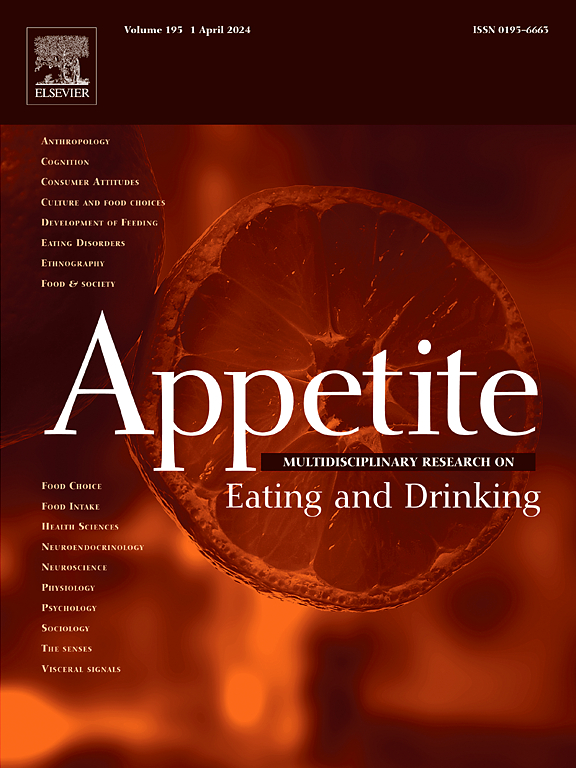Psychological induction of interoceptive hunger cues and their effect on food desire
IF 4.6
2区 医学
Q1 BEHAVIORAL SCIENCES
引用次数: 0
Abstract
Certain interoceptive hunger cues are caused by gut physiology. These interoceptive cues may have psychological consequences, namely an ability to enhance the desire to eat, which are independent of their physiological cause. Testing this idea is difficult because the physiological processes are normally linked to any consequence. In this preliminary report we attempted to induce an interoceptive hunger cue (a stomach rumble), to examine its psychological consequences independent from its physiological cause. In three online Studies (1–3), participants viewed images of food while listening to different sounds including quiet stomach rumbles and judged the source of the sound, and their desire to eat the depicted foods. In Studies 1–3, irrespective of when they last ate and their reported level of hunger, and relative to control sounds, stomach rumble sounds enhanced desire to eat depicted foods, especially when they were mislocalised to the participants’ own stomachs. In Study 1 49% of participants reported some degree of mislocalisation, 74% in Study 2, and 77% in Study 3. Overall, around 40% reported mimicry, where they felt that hearing the computer-generated stomach rumble sound induced the same in themselves. In Study 3 heart beat sounds were included. These too were mislocalised, and enhanced desire to eat depicted foods. In sum, this preliminary report suggests it may be possible to psychologically induce interoceptive cues, including one specific to hunger, and that these cues may then enhance food desire when mislocalised to self. In addition, the findings support the idea that interoceptive hunger cues may have associative properties that augment desire to eat.
内感受性饥饿线索的心理诱导及其对食物欲望的影响。
某些内感受性饥饿信号是由肠道生理引起的。这些内感受性线索可能会产生心理上的影响,即增强食欲的能力,而这与生理原因无关。验证这一观点是困难的,因为生理过程通常与任何结果相关联。在这个初步报告中,我们试图诱导一个内感受性饥饿提示(胃的隆隆声),以检查其独立于其生理原因的心理后果。在三个在线研究(1-3)中,参与者一边观看食物图像,一边听不同的声音,包括安静的胃隆隆声,并判断声音的来源,以及他们吃描绘食物的欲望。在研究1-3中,不管他们最后一次吃东西是什么时候,也不管他们报告的饥饿程度是什么,相对于对照声音,胃的隆隆声增强了他们吃所描述食物的欲望,尤其是当这些声音被错误地定位在参与者自己的胃里时。在研究1中,49%的参与者报告了某种程度的定位错误,研究2中为74%,研究3中为77%。总的来说,大约40%的人表示会模仿,他们觉得听到电脑产生的胃隆隆声会让他们自己产生同样的模仿。在研究3中包括了心跳声。这些都是错误的本地化,并增强了人们对描绘食物的渴望。总之,这一初步报告表明,有可能从心理上诱导内感受性线索,包括一个特定于饥饿的线索,当这些线索被错误地定位到自我时,这些线索可能会增强对食物的渴望。此外,研究结果支持了内感受性饥饿线索可能具有增强食欲的联想特性的观点。
本文章由计算机程序翻译,如有差异,请以英文原文为准。
求助全文
约1分钟内获得全文
求助全文
来源期刊

Appetite
医学-行为科学
CiteScore
9.10
自引率
11.10%
发文量
566
审稿时长
13.4 weeks
期刊介绍:
Appetite is an international research journal specializing in cultural, social, psychological, sensory and physiological influences on the selection and intake of foods and drinks. It covers normal and disordered eating and drinking and welcomes studies of both human and non-human animal behaviour toward food. Appetite publishes research reports, reviews and commentaries. Thematic special issues appear regularly. From time to time the journal carries abstracts from professional meetings. Submissions to Appetite are expected to be based primarily on observations directly related to the selection and intake of foods and drinks; papers that are primarily focused on topics such as nutrition or obesity will not be considered unless they specifically make a novel scientific contribution to the understanding of appetite in line with the journal's aims and scope.
 求助内容:
求助内容: 应助结果提醒方式:
应助结果提醒方式:


